It’s not called “rainforest” for nothing
April 16, Day 8.
I put the family on their respective flights back to Adelaide and Sydney then had some time to kill before part 2 of the trip would properly begin when Paul Coddington arrived tomorrow. For now, I headed back to the Esplanade to see if the Nordmann’s was still around. It would be a lifer for Paul so we planned to try as soon as he arrived, but I figured it would not hurt to check it out today.
Sadly a long hot session of 3 hours back and forth along the Esplanade did not yield my quarry. A lone Black-necked Stork patrolled the mudflats, along with several Great Egret, and still a few waders: Great Knots, Bar-tailed Godwits, Grey-tailed Tattlers and a couple of Terek Sandpipers. But there was no sign of the Red-necked Stints, nor the Common Greenshank, and no sign of Nordy, so perhaps they had all departed together over the last week. One of the many fig trees along the esplanade was very active with birdlife; my attention was initially drawn by a large number of Peaceful Doves on the grass underneath. They were grabbing the spoils of the messy eaters above: Figbirds, Varied Honeyeaters and a few Double-eyed Fig Parrots. It was great to meet Magen Pettit, another name/face I vaguely knew from Facebook, though I felt for her — she’d arrived on an early flight from Darwin on a dedicated twitch of 48 hours. We established from another local birder that it had been seen yesterday, the 15th, but it was not looking good for 16th when I left her at 2pm to return the rental car to Jucy.





I was booked in for one night to the same hotel we’d stayed in earlier in the week, the Cairns Colonial Club. It was not very expensive, and is as convenient for the Botanical Gardens as anywhere — in fact after checking in I walked straight back to Centenary Lakes for some late afternoon birding. TBH it was pretty slow, but I maintained my record of a new bird every day when I came across a young Pale-vented Bush-hen. In PNG 2008 we’d heard this a few times but they seemed to be loud but skulking and we were never able to coax one into view. This Cairns bird, perhaps because it turned out to be a youngster, was fairly curious and bold, and was tempted out to the edge of the track by a small amount of playback and pishing.


April 17, Day 9.
The following morning I walked a final time around the gardens, which once again once delivered a new bird: Common Cicadabird. I was glad to get this because it was an increasingly embarrassing gap in my Australian list, being just about the widest spread and commonest bird I was still missing. At 10.30 I left in an Uber for downtown Cairns to pick up a new car for the time with Paul. Why I didn’t just keep a car for two weeks is a slightly complicated and rather dull story, but in the end came down to a saving of nearly $1000.


The car for the second week was still 2WD, but a slightly roomier Kia Cerato from Enterprise. I picked this up downtown at the allotted time and drove directly to the airport where Paul’s flight had just landed at 10.45. As we drove out on the access road a flash of red zipped past and and I realised I’d just seen one of Paul’s targets for the week, Scarlet Honeyeater. Sadly, he still needed it, having missed the fleeting glimpse altogether. It wasn’t possible to stop, but I felt confident this would be a gimme some time later in the week, surely? Another hour on the Esplanade did not deliver the Nordmann’s so we departed Cairns with a double-dip. I hoped this would not be an omen for the rest of the week!
For our first night I had booked us into Cassowary House in Kuranda. This place is famous in birding circles as a spot regularly to see Southern Cassowary, so I had deliberately booked in for two nights originally, as a backup in case my Mission Beach plan failed (see part 1 here). Because of my rental car cock-up I couldn’t use the first night and stayed in Cairns, but we headed to Kuranda now to begin our rainforest birding. Cassowary House used to be owned by Phil and Sue Gregory, well-known birders in Qld and New Guinea. In fact 18 years earlier Steve Young and I had paid Phil a deposit to lead a trip to PNG in 2004. That trip got canned and a few years later we booked with Birdquest to go to “Remote PNG” (see report here). I have still not made it to some of the places we intended in PNG, such as the central highlands and Fly River, nor have I even ever met Phil, much less birded with him. Anyway, back to the point, Phil and Sue sold Cassowary House just over a year ago, and the new owners, for all their love of the forest and the fact the Cassowaries still visit (though they do not put fruit out like Phil and Sue used to do), do not know the birdlife and were unable to help us with any recent gen. Local birding know-how was one of the reasons birders visited Cassowary House over the years, so we couldn’t help but wonder if the new owners have misjudged their market a bit. It will be interesting to see if they are able to make a success of it going forward.
We spent the heat of the afternoon lazing and even dozing in the garden looking up to the canopy. Dusky, Yellow-spotted and MacLeay’s Honeyeaters visited a flowering tree, and we found a single Wompoo Fruit-dove but it was too poorly situated high in the canopy for any photos. At one point a raptor cruised through, and on jizz I was sure this was a Pacific Baza. But it was only visible through a narrow window in the canopy from my vantage point, and Paul did not get on it. Baza was another of Paul’s targets, so he was now at 0-from-3. Oh dear! Although the new owner Leonie told us she’d seen the Cassowary earlier in the day, we saw no sign. Fortunately I was somewhat relaxed on that front.
Later in the afternoon we walked along Black Mountain Rd, the first of three times; we also ventured along the road at night spotlighting and again earlyish the next morning. We accumulated a nice array of birds on the walk, with Barred Cuckooshrike a lifer for both of us. Several were observed in the canopy over the road, though some clouds had rolled in so our views were mostly a bit washed out against a diffuse white sky. I also made sure to nail unequivocal views of Fairy Gerygone; although sweet singers, the Gerygones are underwhelmingly bland in their plumage, but Gerygone palpebrosa personata is arguably the smartest of the whole family, breaking the drab mould with its dark chin and white moustachial streak.
Kuranda for dinner later that evening was nearly a compete bust. A week ago for lunch the family had enjoyed a reasonable choice of lunch venues, but Paul and I discovered that Kuranda becomes a ghost town at night; most places were closed, and the pub, although open, was not doing food. In retrospect I guess this should not have been a surprise given that most visitors are delivered either by the train or by the Skyrail cablecar on day trips. The only place we could find open was a Thai restaurant, and they were dealing with a backlog of takeaway orders and warned us of a long wait. With no other options available to us, we assured the staff we would be happy to wait the 45 mins or so, and grabbed some beers from the bottle-o at the pub to while away the time. After what turned out to be a rather good Thai meal (worth waiting for, not that we had a choice) we went back to Cassowary House where we fired up the torches and walked along the driveway and along Black Mountain Rd for one of the least successful spot-lighting trips I have ever done (and I have had some poor ones). We didn’t even find a Brush-tail Possum or Pademelon.
April 18, Day 10:
Today was, as I look back on it, a cracker, even though it started life in our itinerary as a bit of a transit day.
Early morning we walked Black Mountain Rd again seeing many of the same species from yesterday, but also adding nice views of Yellow-breasted Boatbill (a lifer for Paul). If I’d not picked up Cassowary last week, I would have waited around the guest house hoping, and maybe even stayed for as long as it took. But my successful Mission Beach mission meant we could leave Kuranda fairly early at around 8.30am, and head ultimately for the Daintree via the inland route, birding at various places along the way.


Our first stop was just before we got to Mareeba at the bridge over the Barron River, where Paul had noted there were regular recent ebird reports of Scarlet Honeyeater. We dipped :-(.
But then things took a turn for the better in the unassuming Jack Bethel Park on the outskirts of Mareeba. White-browed Robins and Buff-sided Robins are close relatives that have variously been lumped or split, with current taxonomy having them as separate species. Paul and I had enjoyed the latter as a lifer in Kakadu 8 months earlier (report here). I now needed White-browed for my box-set of the Australian robins (though I have not seen White-faced in Australia, only New Guinea), but of all the birds we were targetting for the week, this was the one with the fewest ebird records, and none showed as red hotspots on the ebird map, meaning no-one had made a report within the last month. We arrived at the park with pretty low expectations, given the scarcity and age of the most recent gen, and walking through a pretty ordinary looking suburban park my hopes were not raised. Without much expectation I tried some playback and we were amazed to hear a bird sing back almost immediately. In fact this short burst set off two White-browed Robins, presumably holding neighbouring territories, and our first views of the robins were as they chased each other around the canopy, too active and flighty in their scrap for us to get any decent views, let alone pictures. I felt rather guilty at setting off this behaviour, but fortunately they settled back to their own spots and continue to sing. Even so they remained tricky to pin down, but with persistence we eventually managed superb views and some decent photographic opportunities.




Enthusiasm and belief restored we drove back into Mareeba to grab coffees. Waiting for our brews, we looked across the road to see the infamous Bob Katter’s electoral offices opposite, a reminder that we were well and truly in redneck territory up here. Suitably caffeinated we were emboldened to try the bridge again for Paul’s bogey bird, and on the other side of the river we found a couple of bushes in flower and attractive to local honeyeaters. We were finally able to land Paul’s lifer Scarlet Honeyeater but we also picked up a nice Yellow Honeyeater and Brown Honeyeater for a cool trifecta of honeyeaters named solely for their colour (the only other birds in this category are Black and Grey Honeyeaters).


At Big Mitchell Creek we hoped for more robins and maybe finches, but it did not deliver much, other than our first drizzle. Mt Molloy was a convenient (the only possible) lunch stop and at the quaint and interesting general store and cafe, run by an old Mexican couple, we were persuaded to try a burrito with her home-made chilli sauce (it was a really good sauce, living up to her billing of deep, hot and spicy without being completely overpowering). We then drove around the town scanning various open, grassy areas which Dolby suggests can be good for Squatter Pigeon. After drawing a blank at the oval, we found ourselves on the road leading to the local school, first finding a Great Bowerbird (only after we’d left did I read that there is apparently a bower at the school itself), then Paul spotted some pigeons in a paddock opposite the school. Careful scrutiny revealed 5 Squatter Pigeon feeding quietly in the uncut grass.
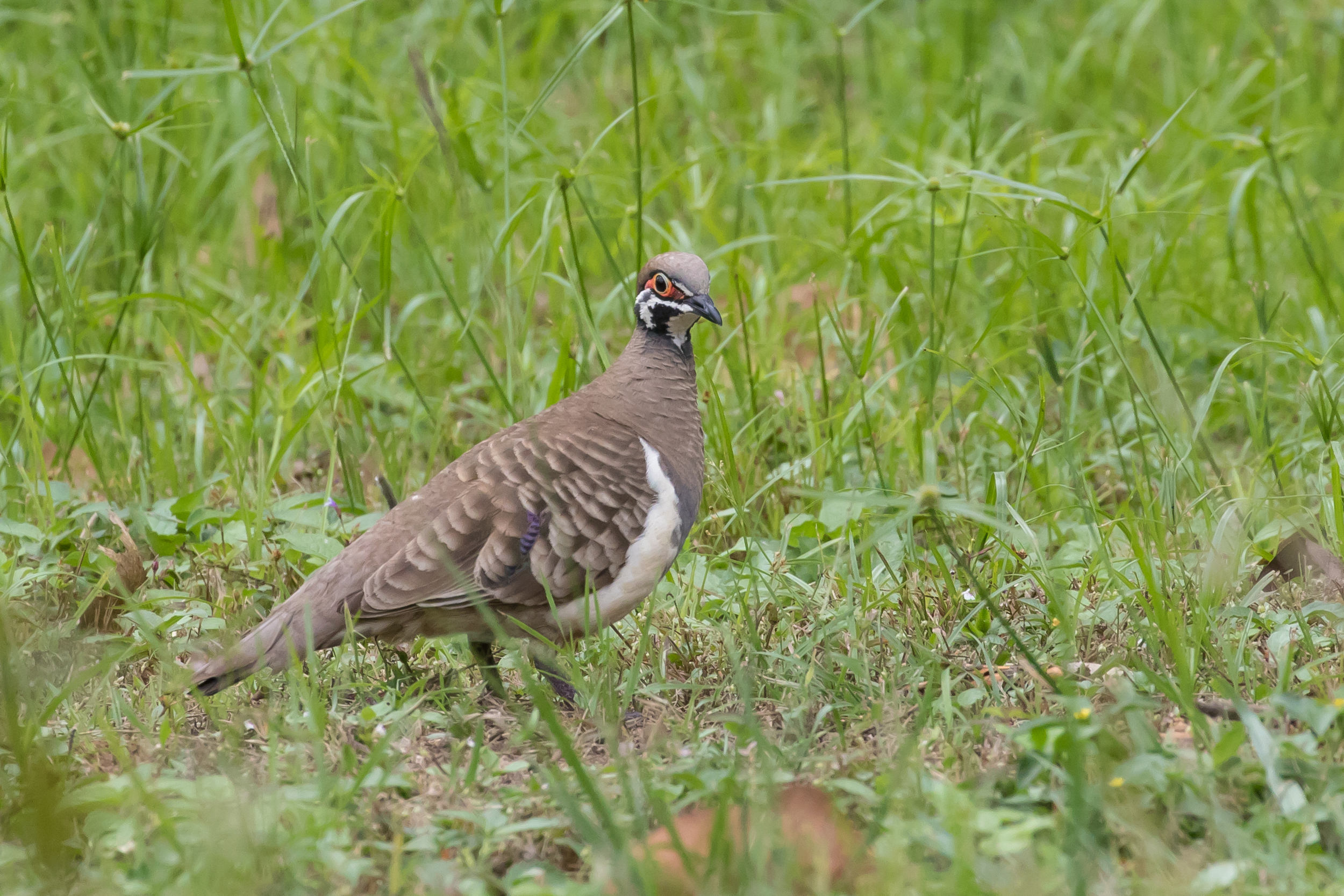
Immediately north of Mt Molloy the main road carries on truly far north to places like Cooktown, Weipa and Iron Range, but here we turned off east heading back to the coast. Within the space a few a kilometres the vegetation switched from drier savannah and cattle ranches to rainforest and wet farmland as we travelled through Julatten, skirting the southern edge of Daintree National Park before plunging down a steep, winding road through the national park to the coast. We stopped again in Mossman where a brief glimpse of a raptor caught our attention. Thinking it might have been Paul’s elusive Baza we tracked it down, finding a nice (but not lifer) Grey Goshawk. And north of Mossman we diverted to Newell Beach but didn’t see a great deal of interest there other than Little Tern and certainly not the hoped-for but very low probability rare swallows — Red-rumped and Barn — that have been seen there in the past and the chance of Beach Stone-curlew.
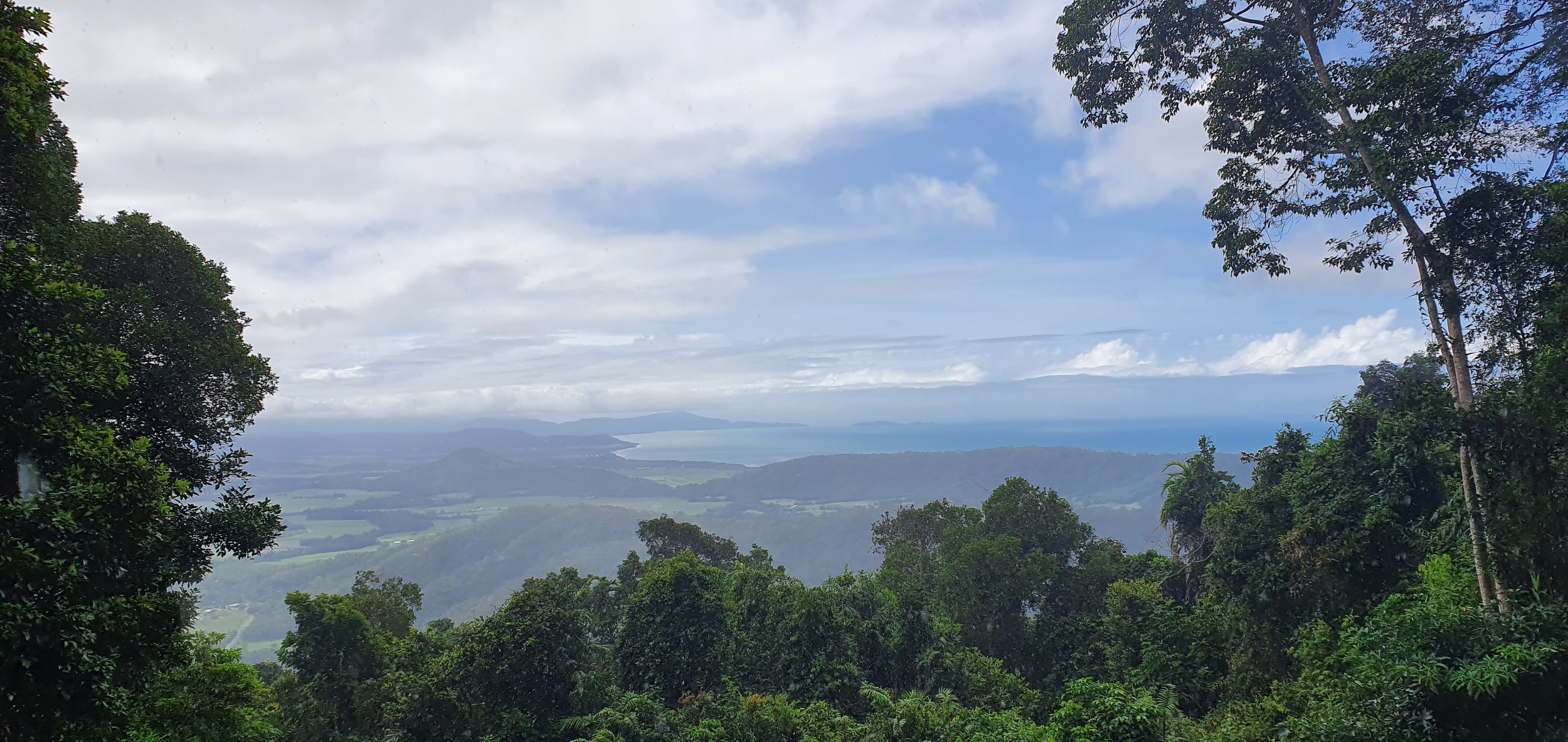
On arrival in Daintree village the weather started to deteriorate. We called in here to make sure we knew how to find the boatramp where we had an early river cruise booked tomorrow morning, but also because Daintree is one of the spots we’d earmarked for Lovely Fairywren, my last the Australian Fairywrens. Although the male looks like various other “variegated-type” fairywrens, the female is quite different, the smartest of all female FWs with a lovely blue cap that affords it a rare beauty. Also unlike the variegated-types which are pretty common in their range, Lovely seems to be quite localised.
Dolby’s blog and book recommend near a “water tower”. We looked in vain for this, wasting quite a bit of time driving driving back and forth until I swallowed my embarrassment, walked into the cafe/information centre and asked if they knew where the water tower was. “Over there, up heart-attack hill” was the response, pointing to a track that we’d inspected earlier and dismissed as being too steep to drive in our 2wd and looking very like a private driveway. “Is the water tower walking distance?”, I asked. “How many heart attacks do you want?” was the good humoured hyperbole in response. Though it was very steep, it was actually easily managed on foot ’til we found ourselves next to a sizeable water storage tank (not a tower!). At this point it started to rain in earnest and we sheltered under the canopy, hoping it would pass quickly. When it didn’t, I decided to carry on walking up the track. After a couple of hundred metres I heard tell-tale squeaking and seconds later a stunning female Lovely Fairywren popped out to investigate my pishing. Paul did not need Lovely Fairywren for his life list, and was also anxious to keep optics very dry (new camera!), so he had not joined me, but since I seemed to have pinned them down I texted him. He arrived 5 minutes later and got tickable views for his trip list, but the best of the performance was over.
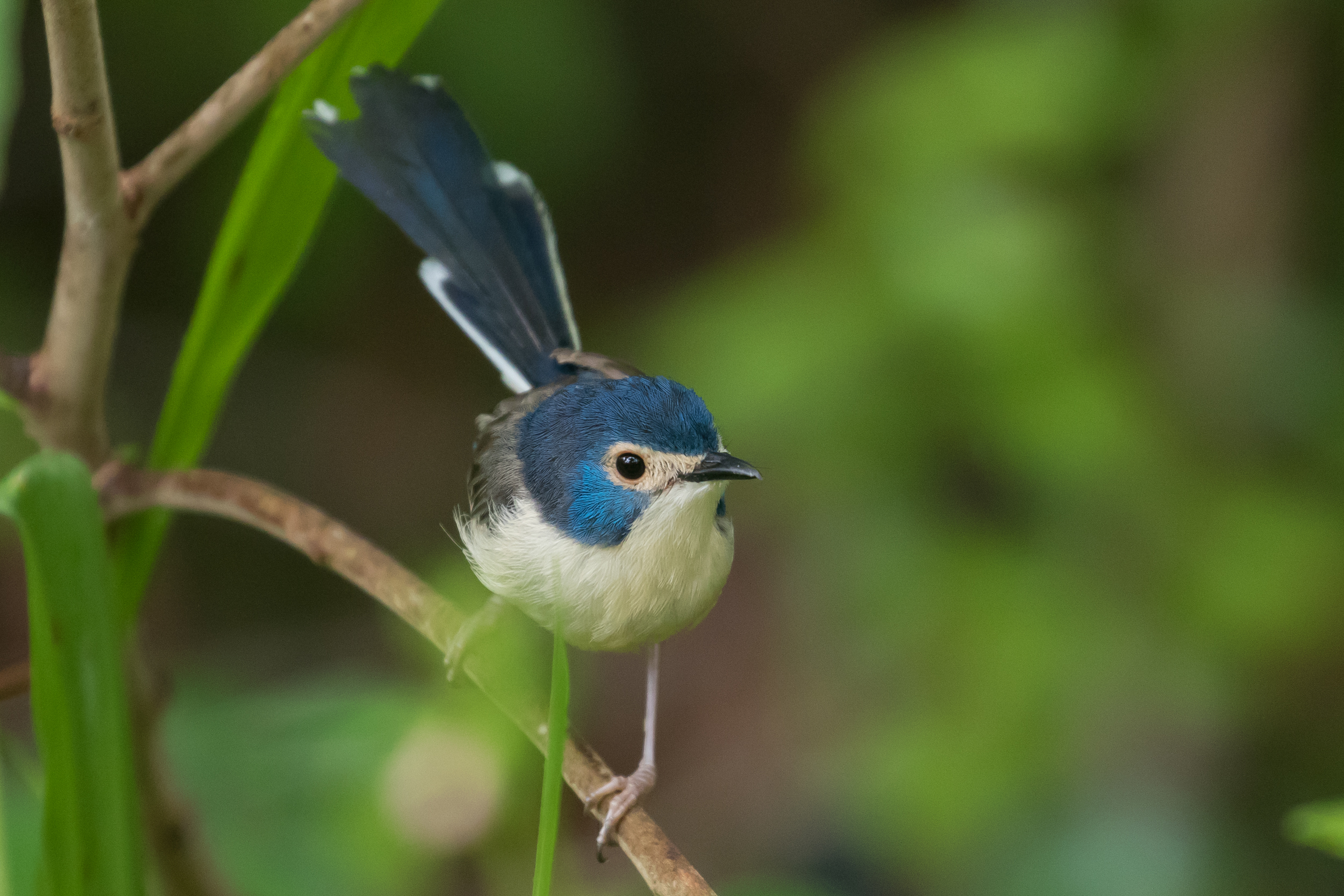
A lack of available accommodation in the village, as well as my desire to visit the world famous Daintree Forest, meant we still had to get north of the river where I’d booked us into Daintree Crocodylus for the night. The only way to get there is by cable-ferry, so we lined up at the boom-gate, waited for it to arrive, then drove our car on, much as we are used to in places like Morgan and Waikerie where the same mode of transport is the only way to cross the River Murray. Unlike those ferries however, which are free, the Daintree Ferry stung us for $30 return. If this sum is effectively an entry fee to the National Park and goes towards park upkeep then I have no problem with it, but somehow I suspect that’s not the case. Or maybe we were paying for the privilege of having an Olive-backed Sunbirds accompany us on the journey over.
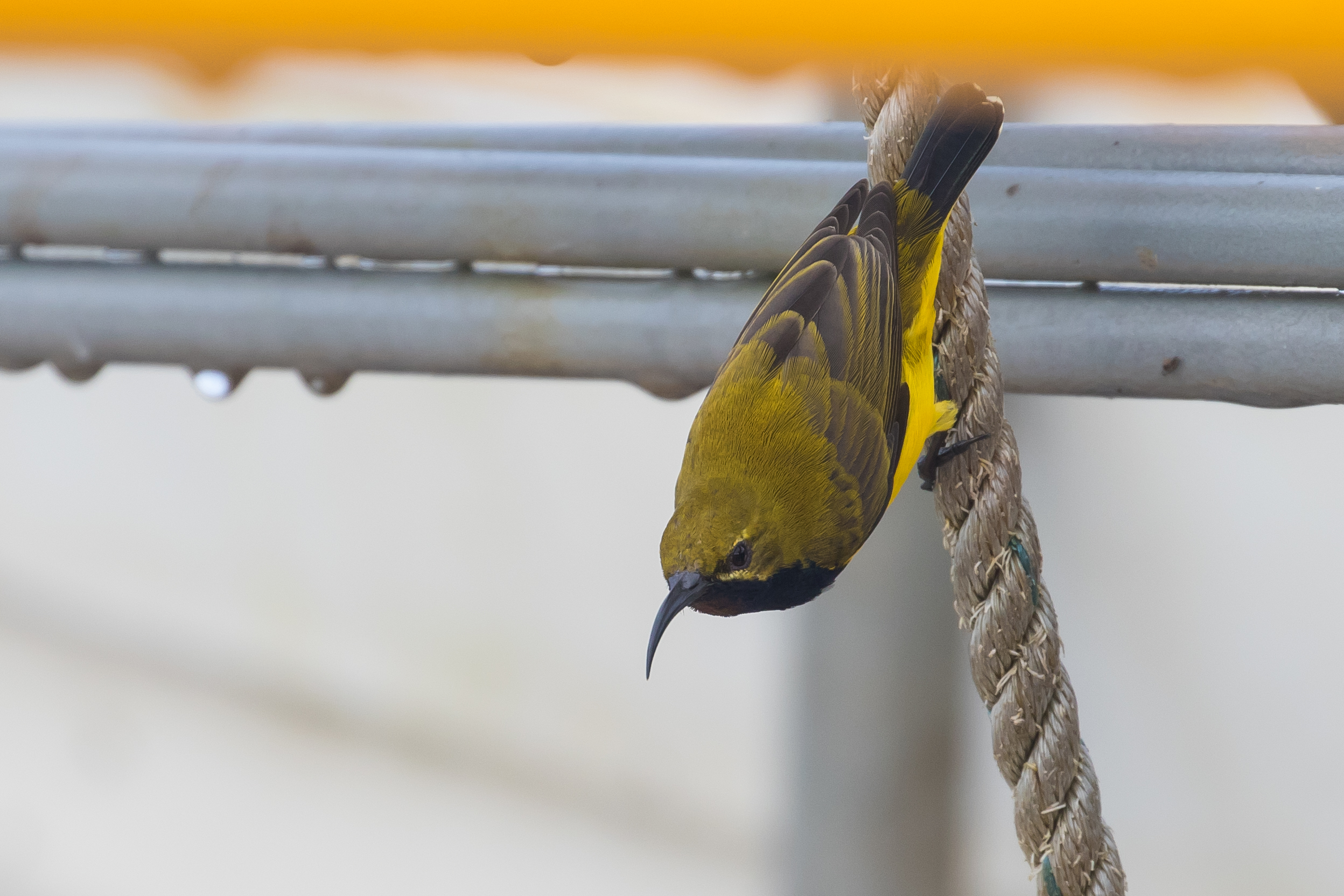
The winding drive through the forest to Jindalba Boardwalk was slow but scenic — as much as the darkening sky and forest permitted — and the boardwalk was our next destination because of recent reports of Buff-breasted Paradise Kingfisher. As we arrived there was a couple walking back to their car sporting bins and a long lens. “Seen anything interesting?”, I asked, fully expecting a standard “not much” reply but instead they said: “There’s a Cassowary down there. It was right here on the side of the road, but it’s now in the forest, about 30-40m away. I don’t think it’s gone far.” Cue excitement, but this time without the tension and angst that accompanies a potential lifer. A short way down into the carpark (as it turned out) we started peering into the forest and within seconds Paul announced he could see it. I looked into the gloomy jungle in the same direction and saw a large brown blob. Was this an imm. bird? No, the brown blob is just a rock. But the big black blob behind suddenly moved and I could now see the bright red and blue neck between leaves as the monster Southern Cassowary reached down to feed from fallen fruits. You beauty! Meantime, Paul had convinced himself that all he could was is a big black tree stump. Until it lifted its head again, and he could now see it. It’s only this kind of experience that shows how such a big bird can blend so unobtrusively into the forest.
We watched for several minutes, first as it fed in a narrow gully along which we managed to get a fairly unobscured view, and then fantastically as it walked across the carpark in the open in front of us to feed on the forest edge. This bird had a much larger (and slightly skewed) casque, that almost appeared golden when catching light once or twice, and its huge dangling pink wattle swung like an old man’s empty nut-sack as it loped across the clearing. We still could not get any decent shutter-speeds even with ISO6400, but we still filled our memory cards and then left the bird in peace (not that it appeared disturbed by our presence at any point).






The walk through the forest on the board walk was an anticlimax compared to the experience in the carpark. We saw no birds at all (including no sign of BBPK) though it was still an excellent experience of the Daintree jungle. Part way along it began to rain again, and this time was quite heavy.
Overnight at the rustic Daintree Crocodylus was a throw-back to various tropical birding lodges I’ve stayed in, with open-air dining and un-air-conditioned rooms with mossie-nets providing a cheap and no-frills eco-experience. It may not be for everyone. In fact the booking confirmation email I received was at pains to describe the place:
Please read the following in detail to ensure you are right for us and we are right for you BEFORE you come stay.
We are very JUNGLY and our rooms and in fact the whole place are focussed on maximising your and fellow guests rainforest immersion experience. We embrace the practice of rainforest bathing by being silent (like a yoga retreat) between 9.30pm and 6am) so the jungle does the talking, have a no-power phase during the day (10.30am-5pm) and overnight (10.30pm-7am unless super hot when we leave it on), and our rooms are minimally furnished with just a bed, a mozzie net, a couple of hooks and a bench to put things on plus a table and chairs on the verandah. This as with the whole of our lodge, allows you to focus on re-wilding without any of the distractions of modern life. If this does not appeal and/or you want mod-cons please cancel your booking (free of charge if done within 24hrs of booking) – you will not be happy in our re-earthing environment.
I loved the feel of the place and have total respect for the super-friendly, hippy proprieters and what they are trying to achieve.
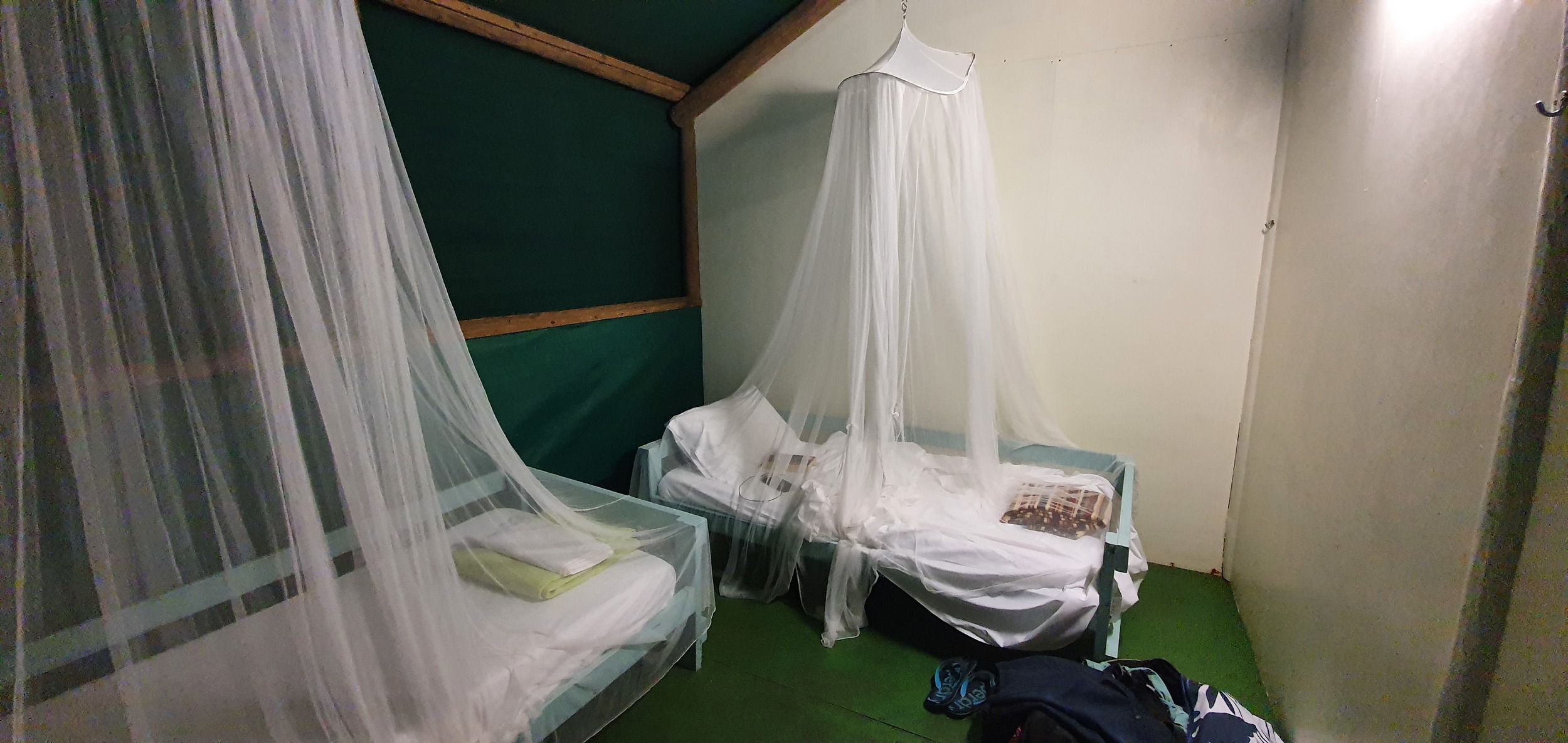
Of course, the weather decided to deliver the whole rainforest experience quite literally: the rain on the canvas roof of the room was loud and unceasing. In fact it barely let up for the next 5 days!
April 19, Day 11
A very early pre-dawn rise was necessary to make it to the ferry, cross the Daintree River and drive to the village in time for our 7am cruise with Murray Hunt (Daintree Boatman Nature Tours). Murray did his best to deliver a quality experience for us despite the rain coming and going throughout the cruise, and largely succeeded, though the rain kept a couple of the stars we’d hoped for (Great-billed Heron and Papuan Frogmouth) away ![]() . We did have 4 species of kingfisher — Forest, Sacred, Azure and Little Kingfishers, and slightly bizarrely given weather, a good array of raptors: Whistling Kite, Osprey, 3 White-bellied Sea Eagles, and even a scarcity for the area, Wedge-tailed Eagle! There is also something quite marvellous about pootling up and down a river watching wildlife from a boat, whether or not you see rarities — the Yellow Waters Cruise in Kakadu (where Murray used to pilot tourists around) was another similar experience, and of course my personal favourite, the Kinabatang River in Borneo.
. We did have 4 species of kingfisher — Forest, Sacred, Azure and Little Kingfishers, and slightly bizarrely given weather, a good array of raptors: Whistling Kite, Osprey, 3 White-bellied Sea Eagles, and even a scarcity for the area, Wedge-tailed Eagle! There is also something quite marvellous about pootling up and down a river watching wildlife from a boat, whether or not you see rarities — the Yellow Waters Cruise in Kakadu (where Murray used to pilot tourists around) was another similar experience, and of course my personal favourite, the Kinabatang River in Borneo.




The persistent rain was a perfect excuse to indulge a large breakfast at the local cafe. We grabbed groceries at Mossman but otherwise drove directly to Kingfisher Park Birdwatchers Lodge without birding en route. Consequently we arrived there somewhat before check-in, as the first guests of the season, but Carol Iles was there waiting: “When I saw the weather, I thought you might arrive early”.
We had some lunch in the communal kitchen area and I watched the feeders for a while (Bar-shouldered Dove, Yellow-spotted Honeyeater, MacLeay’s Honeyeater, Blue-faced Honeyeater, Rainbow Lorikeet) as Paul dozed for a bit. The rain persisted and we decided on a mid-afternoon drive to Mt Carbine hoping that by heading inland to normally drier country we might escape the rain and have a crack at Black-throated Finch. No such luck.
Back at KFP we walked down through the orchard, finding ourselves at the pond just in time to hear a Red-necked Crake. This particular spot is famous in Australian birding circles as a regular site for this skulker and many birders have had their first (sometimes only) encounters here. So regular are these birds that Carol and Andrew (and their predecessors) put out chairs to make viewing the “show” a little more comfy. But Andrew had collected the seating an hour earlier as the level in the creek rose with all the rain and threatened to carry them away! Standing, waiting in the gloom, it was too dark even to bother with the cameras, so we watched the dim bank intently until a pair of shapes emerged from a tangle of branches and leaves. There was just enough light to make out the orange/red head and neck of one of the birds (it’s always nice to get a good view of the eponymous feature of a bird). After a pretty slow and unsuccessful day this sighting managed to keep intact my record of at least one new bird every day of the trip.
We cooked pasta in the kitchen area, sat on the verandah to see if any nice mammals might visit, then retired to the bunkhouse (because we’re cheap-skates). Again it rained all night.
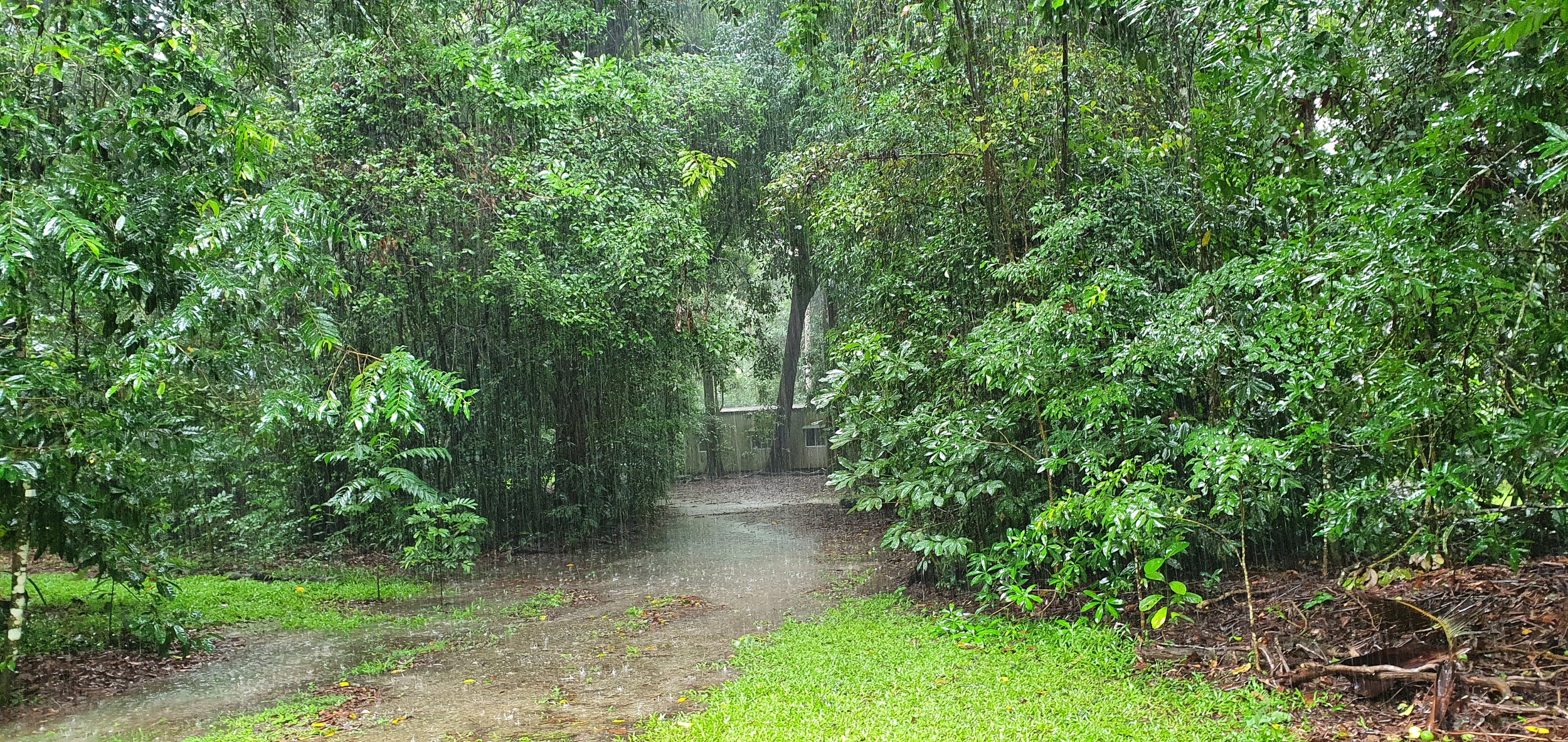
April 20, Day 12
There was no sign of an improvement in the weather, and to make matters worse we discovered that we were “trapped” — there was a landslide on the Rex Range Rd so no going back to the coast, while Bushy Creek, which flows along the back of KFP property and then under the road about a km east, had risen up above the bridge and flooded the causeway just a km east of KFP.
We decided to explore in the car, following some leads Carol gave us which turned up trumps. First we headed for Carr Rd, and drove slowly until we reached a wide lawn and noticed a bunch of Pademelons, including a couple with joeys in their pouches. A sign by the driveway explained that this was Pademelon Sanctuary, but before I could read any further I noticed a bird sitting on the letterbox: Buff-breasted Paradise Kingfisher! This was sporting the big orangey-red bill of an adult, but its tail was behind the box out of sight. I manoeuvred the car carefully hoping not to flush it, so we could both get views and photos through an open window. As with almost all the photographic opportunities on this trip, the ISO was way up so pics were grainy and often motion-blurred because of slow shutter-speeds. But the more you take, the more chance there is some will turn out. It flew across the road, but landed still in full view and now we could also see its outrageous long white tail. In the end we spent a good ten minutes with this bird, most of which we were using the car as a hide. It’s funny how 2 tons of steel, rubber and plastic are usually not perceived as a threat compared with a dude and a camera.




While watching the Kingfisher a cuckoo called. We wondered and hoped for Chestnut-breasted, but it did not respond to playback and as we drove away I convinced myself the call was in fact Fan-tailed. However another local road had been recommended by Carol as a possibility for Chestnut-breasted Cuckoo, so we headed there once sated with our Kingfsher experience. We pulled up a km or so along Clacherty Rd adjacent to some decent looking forest, and almost immediately heard a slightly higher, and shorter trill from the forest — the contrast with the earlier song on Carr Rd made us now certain that we were hearing Chestnut-breasted. Carol had also suggested that a monosyllabic whistle, the unobtrusive contact call, would be uttered more often than the song and would probably be better for attracting them. Fortunately it is a simple-enough sound that we were able to whistle it, and sure enough the birds — there were at least two — were interested. I finally tracked one down to a perch where we both obtained decent views of Chestnut-breasted Cuckoo and some record shots.


Emboldened by our early successes with BBPK and CBC, we decided to try our luck on Mt Lewis, despite the rain. Mt Lewis is the only readily accessible part of the impressive Daintree National Park and Brooklyn Sanctuary, and holds most of the key species of the area. The road itself was easily passable using our 2WD, so I can only imagine it is much better now than my encounter 24 years ago. At the 3km mark we stopped at the world heritage sign, as suggested in Dolby and Clarke, and birded on foot for a bit, though we did not find much of note: Pale-yellow Robin, Yellow-spotted Honeyeater and Dusky Honeyeater, with a flock of eight Australian King Parrots the best sighting.
Back in the car, another km on, our hearts sank: there was a fallen tree across the road. At first sight it seemed like a fairly slim, young tree, so maybe we could shift it by hand. The first big branch broke off and we could drag it away with a bit of force, but then the slightly thicker trunk would not budge — it was firmly wedged on both sides of the road and totally immovable. We returned to KFP for some lunch and I reported the tree to Andrew. He was hopeful that once he’d reported to the local council they would be fairly prompt: “They usually clear trees within 24 hours — council workers would rather come out on a mission that involves playing with a chainsaw than clearing a drain!”. If Andrew was right, at least we’d probably get a chance to bird up the mountain tomorrow, but we still needed a plan for the afternoon; it was still basically impossible to leave Julatten, and now the top of Mt Lewis was inaccessible too. We had run out of options, so we decided to return to the 4km mark by the fallen tree, and bird in the rain, on foot, up the mountain as far as walking could take us.
After lunch we returned and birded on foot, as planned. Cameras were left in the car to stay dry, so there are few photos, not that we found many birds worthy of a photograph anyway. A Brown Cuckoo-dove in a fruiting tree might have been a sign that there was more about, but proved to be the only bird in that particular tree. However a bit further into the forest and a bit higher up the road we heard a Riflebird, and as I scanned the distance canopy I landed bins on a large, dark bird. I realised this was not the Riflebird, but I had lucked onto a Tooth-billed Bowerbird, a lifer! Having dipped on this last week I was relieved to claw it back, though it was impossible to describe where I was looking to Paul, and I was sure if I took bins away I would lose it altogether, so no chance of a photo even if I’d had the camera. Fortunately this was not one of Paul’s target species.
A Golden Whistler gave us the run-around because it sounded sufficiently different to the ones we are used to in the south that we though the perpetrator must be something rarer or more interesting. A few Australian Swiftlets braved the rain and continued to fly around, and we also noted more Australian King Parrots, Spectacled Monarch, Grey-headed Robin and Yellow-spotted and Bridled Honeyeaters. A scrubwren scratching out it buzzing alarm call had us interested, hoping for Atherton, but when I tracked it down it was just a Yellow-throated Scrubwren.
We had been birding for about a km up the road when the sound of a truck approaching drifted up the track. It didn’t take much cognitive power to realise this must mean the road had been opened up, and sure enough from around the corner, a pair of council vans appeared. We thanked them for their super-swift attention, and as they carried on to top, presumably to check for further obstructions, we walked back to collect the car. I have birded so many times in rainforests to the sound of chainsaws, I could not work out how we heard the trucks approaching, but not the chainsaws. I concluded that they must use quieter battery-powered saws these days.
Liberated by the clear road we carried on to the famous grassy clearing at the top. It was misty and drizzly — still shote for photos even when the rain was not falling — but we were now able to start racking up some lifers again. Mountain Thornbills were positively common and conspicuous with their distinctive song and contact calls. Harder to hear were the finch calls. Red-browed Finches make a similar sound to Parrot-finches, though a bit more strident, and it was 3-4 of these we tracked down first. But we seemed to be hearing the thinner, higher sound of the Blue-faced Parrot-finch as well, and although they were in the long grass out of sight most of the time, occasionally one would pup up to the top of a grassy stem momentarily, so we eventually got views a 4 or 5 through the mist . Other birds noted at the clearing included Eastern Spinebill, Eastern Whipbird, and Lewin’s Honeyeater.



The track to the dam was hard to find — we had to pick our way through the grass to a barely visible “opening” to the track — and we did not venture far in the gloom and rain. It was not a complete bust, though, scoring us our first unequivocal Atherton Scrubwren. At Chambers last week I had tentatively ticked this off, before then unticking when I realised I had strung Large-billed Scrubwren. These two taxa are, in fact, rather similar looking, with Atherton a bit darker and its eye, therefore, less “beady” in the face. But the other factor I had not appreciated was a behavioural one: birds in a flock, mid-storey (like the birds I saw at Chambers), are almost certainly Large-billed. Atherton are usually singly or in pars and closer to the ground.
On the drive down we noted Australian Brush-turkey and Pacific Emerald Dove. As I was photographing a Brown Cuckoo-dove on the track a mammal bounded across. I squeezed out some record shots which we showed to Carol later and she identified for us as Musky Rat-kangaroo. Close to the bottom our second Buff-breasted Paradise-Kingfisher flew across the road, though it was now so dark, and the weather closing in again we didn’t try to track it down.
Our evening food plan had been to go to the pub in Mt Molloy, but the causeway remained under water. For a while it seemed that our only option was to eat our remaining spaghetti “au naturel”. Fortunately Carol made us aware that the local roadhouse does takeaways and I was able to call and place an order for a (surprisingly adequate) pizza with minutes to spare before they closed. Pudding was a treat from Carol — a chocolate cup-cake each!
April 21, Day 13
The rain just kept coming; Andrew had been listening in to various weather reports and informed us that less than a third of the way into 2021 they had already passed 2020’s annual rainfall. The last 3 days had yielded 350mm (the most they’d had in a similar period since the wet season in 2019) and Cairns on the coast had copped 700mm in four days, almost cyclonic! But we had to keep working out how we could make the best of a bad situation. The continued downpour overnight increased the chances that there would be more trees down on Mt Lewis, but with no other options open to us, we decided to risk it. There were still a few key birds we needed up there. Carol advised us to take snacks and water (and packed a couple of delicious rock-cakes for us) and to be prepared to walk down if the worst happened and another tree came down across the road while we were up there.
We travelled straight up the mountain to the clearing where, mindful of the rain, we decided again not to take cameras, and this was quite liberating; no longer worrying about the perfect image we could just enjoy finding and observing the birds. It also freed up hands to carry an umbrella each! This was also useful as we needed regular stops and free hands to rid ourselves of leeches that were out in force.
Our plan today was to walk the dam trail all the way to the dam, about a 4km round trip, hoping primarily for Fernwren, which we both needed, and Chowchilla (which only I needed) and just maybe luck onto a Golden Bowerbird. We had walked barely a couple of hundred metres when I saw a small chunky brown body moving by the side of the track. Instinct — perhaps I subconsciously noticed something interesting about the jizz — told me this was something good and we needed to pin it down. We watched intently in the gloom as it moved carefully on the ground through fairly dense cover until it reached a slightly more exposed location by the track, and we could make out the white throat and super’ of a Fernwren.
The remainder of the 2km to the dam was fairly bird-free (though not leech-free). The track itself had been turned into a stream by the incessant rain, and I was grateful for my waterproof boots and the large, albeit colourful umbrella that Carol had lent me. We stopped regularly to scan likely looking patches of the ground for Chowchilla, but saw nothing, and there was no response to occasional playback. Likewise we listened out for our other target, the weird, beating and totally un-birdlike calls of Golden Bowerbird, but heard nothing. We did “enjoy” some other wildlife, stopping regularly brush off leeches, and seeing numerous Giant Blue Earthworms.


It was considerably birdier on the way back. An early highlight was our second Fernwren that showed brilliantly and for the first time I wished I’d had my camera. Then a dark shape that skidded across a gap in the forest and seemed good for Chowchilla, but we didn’t get enough on it and couldn’t relocate it. Ten minutes and 400m later later as I played the song on my phone a Chowchilla bombed across the track. Then another. And another. And another… I counted 7 birds in a family group chattering their way across the track and down the slope on the other side. They were tough to see on the dark forest floor, keeping close to fallen logs and other cover, and moving away as I scrambled down the slope to try for better views, but with patience and persistence I eventually had decent views of a couple of males with their white throats, though the other birds went down as either female or immature — it was too dark to see the orange throat, and certainly too dark for photography so I was back to being happy and liberated without the 7D2. We followed them some way down into the jungle, and as I made my way back up the slope I noticed two other birds feeding unobtrusively on the forest floor above me: two more Fernwrens!
Back at the clearing it had finally stopped raining but the Blue-faced Parrot-finches were uncooperative. We could hear several calling from the fringes of the clearing, but only laid eyes/bins on one bird. A number of Mountain Thornbill were active around the clearing and a little way down the road we found another couple of Atherton Scrubwren and a Yellow-throated Scrubwren. A few Silvereye flew through, and both Lewin’s Honeyeater and Grey Fantails scolded us.
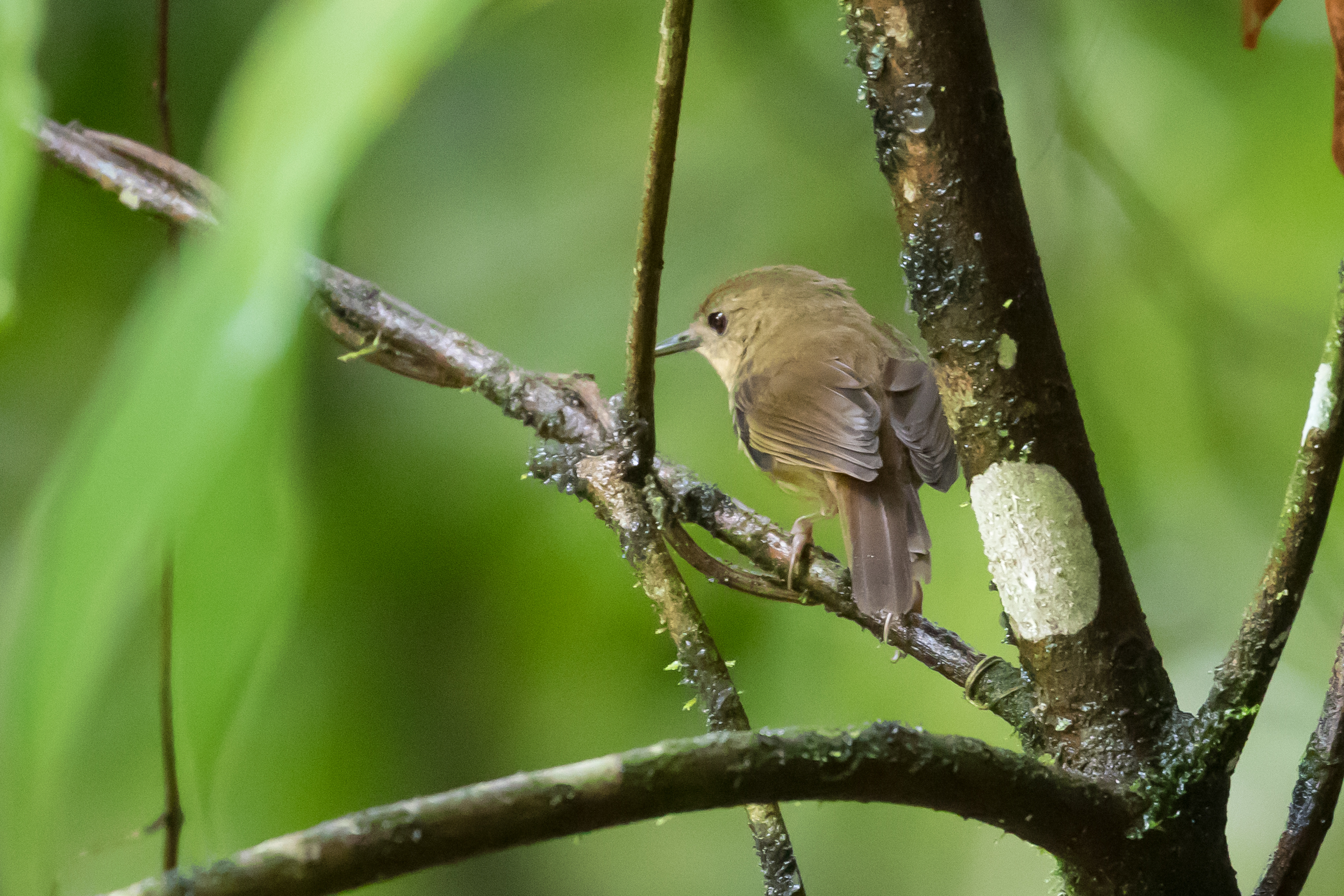
We took the drive down fairly slowly, stopping occasionally and picking up a few Golden Whistler, two White-throated Treecreepers (minor subspecies), Yellow-spotted, Lewin’s and Bridled Honeyeater. We’d been up the mountain for 5 hours and arrived at the junction with the Mt Molloy-Mossman Rd famished. We detoured to the 9-mile Roadhouse (last night’s pizza place) to grab some lunch, and then called in at Kingfisher Park just to let Carol know that we were not trapped up the mountain! Other than Golden Bowerbird, of which we’d had no sniff, we had now got all our targets on Mt Lewis so we hoped to head for the savannah hinterland to look for Black-throated Finches.
A queue of cars at the causeway was not a good sign, but the word was that all were waiting for 3pm when they would open the road if the creek level continued to fall. 3pm came and went, and we worried that time would run out, since our BTF site was a good 45 minutes drive north, and we needed time in the light to search. Finally after 3.30 the council worker in charge had removed debris from the bridge and causeway and deemed the water-level, now 20cm, ok for the general public to cross. In our low-slung Kia rental I was pretty nervous, so we let all the other cars go ahead of us, including a couple of other small 2WDs which we watched with interest. They seemed to be ok, so I supposed we would be too. I kept a slow but steady pace at the back of the train of cars, but then a funny grating noise that felt and sounded like the floor of the vehicle scraping on a sandy bottom had me shitting myself lest we’d done some damage. I pressed on, too far committed now to turn back, and we made it across. Perhaps the noise was just from the pressure of the water on bits of car designed to deflect air normally. I’ve only ever driven through a flood twice, and both times it was with Paul on a birding trip (the first was near Leigh Creek in 2016, before I was blogging).
Liberated from our watery “prison” in Julatten we now bombed north on the Mulligan Hwy through the savannah towards Mt Carbine. As we approached Maryfarms, Paul pointed out the roads to the right East Mary Rd and West Mary Rd are supposed to be good for Australian Bustard (in fact the area is known as Bustard Downs). Unable to resist looking for one of my favourite families, I persuaded Paul we had time for a short detour just in case. This was a fortuitous call because barely 200m along Paul announced there was one on the side of the road. We then realised there were two more birds there, and then two others flew over and landed out of sight in the long grass of the paddock. Now that the rain had stopped and we were in the car we both had cameras again, so I manoeuvred the car and we snapped away, all three birds angling their heads in that characteristic haughty stance. The biggest, presumably male bird was unfortunately behind a barbed wire fence, annoyingly cutting across all my photos, but the smaller bird was not and proved reasonably photogenic. A very successful and very minor detour!



We were heading for a place called Dave’s Dam, near Desailly, acting on a tip-off from Steve Potter (and confirmed by Carol). As we approached the McLeod River some small birds flushed from grass by the side of the highway as we bombed past at 100km/h (afterwards I noted the GPS coords to be -16.50106, 145.01554). We quickly debated whether they were worth checking out and I half-heartedly turned around on the basis that we owed it to ourselves to make sure. This was another great decision, because when we arrived back at the spot there were several species flying around the trees, and shuttling between trees and the grass, including our target Black-throated Finch! This smart taxon was in fact The Guardian’s Bird of the Year in 2019, not least because it is endangered by habitat loss. Approval of the hugely controversial Adani coal mine on the basis of spurious “habitat offset” promises has probably sounded the death-knell for the southern race, because it survives only in small pockets of native grassland that will be obliterated by the mine. The whole idea of offsets is deeply flawed, but even were it not, the ridiculously weak environmental laws that allow death-by-a-thousand-cuts, and the pandering of both state and federal governments of both sides of politics to the small but vociferous coal mining lobby, are scandalous.


As well as the finches, there were Striated Pardalote, White-winged Triller, both White-bellied and Black-faced Cuckooshrike, Blue-faced Honeyeater, and some Varied Sittella. A couple of Diamond Dove were suggested by Carol to be an interesting record for the area, so we were glad to have unequivocal photos of those. For a while I thought we also had Brown-backed Honeyeater, which would also have been a lifer. However I didn’t get any photos of the first birds I saw when I was confident, and later I took a picture of a “possible”, that was clearly a female Triller on review. How could I get it so doddkdowrong? I guess unfamiliarity and eagerness both played a part, though I still can’t explain it properly. And I still think the first bird may have been one, but I simply can’t tick it.
We travelled on to Dave’s Dam, and heard finches there too, but did not see any. Several Apostlebirds were conspicuous, as were a pair of Pied Butcherbirds. But a Brown Goshawk perched near the dam was undoubtedly to blame for the finches keeping a very low profile. As we drove back along Hurricane Rd a Blue-winged Kookaburra showed well, while back out on Mulligan Hwy we noted a pair of Pale-headed Rosellas in roadside eucalypts.
It was great to have dinner at the pub in Mt Molloy, and because this was our first night in Julatten that it was not pissing down, we took the opportunity to go spotlighting on Mt Lewis. Sadly, like our Black Mountain Rd effort of a few nights earlier, this was not very successful. We saw a Long-nosed Bandicoot at the bottom fthe mountain, but no other mammals, and not a peep from any owls. Back at KFP while Paul showered, I heard an interesting screech from next-door Geraghty Park. Grabbing torch and camera once more I walked over to the park and when I saw eye-shine high up in a big gum tree the heart started racing. Could this be Lesser Sooty Owl? Unfortunately my first, blurred impressions were of a quite pale bird, and when I finally did get it in the torch-light and bins focused, it was clearly a Barn Owl. I took a couple of pictures anyway.
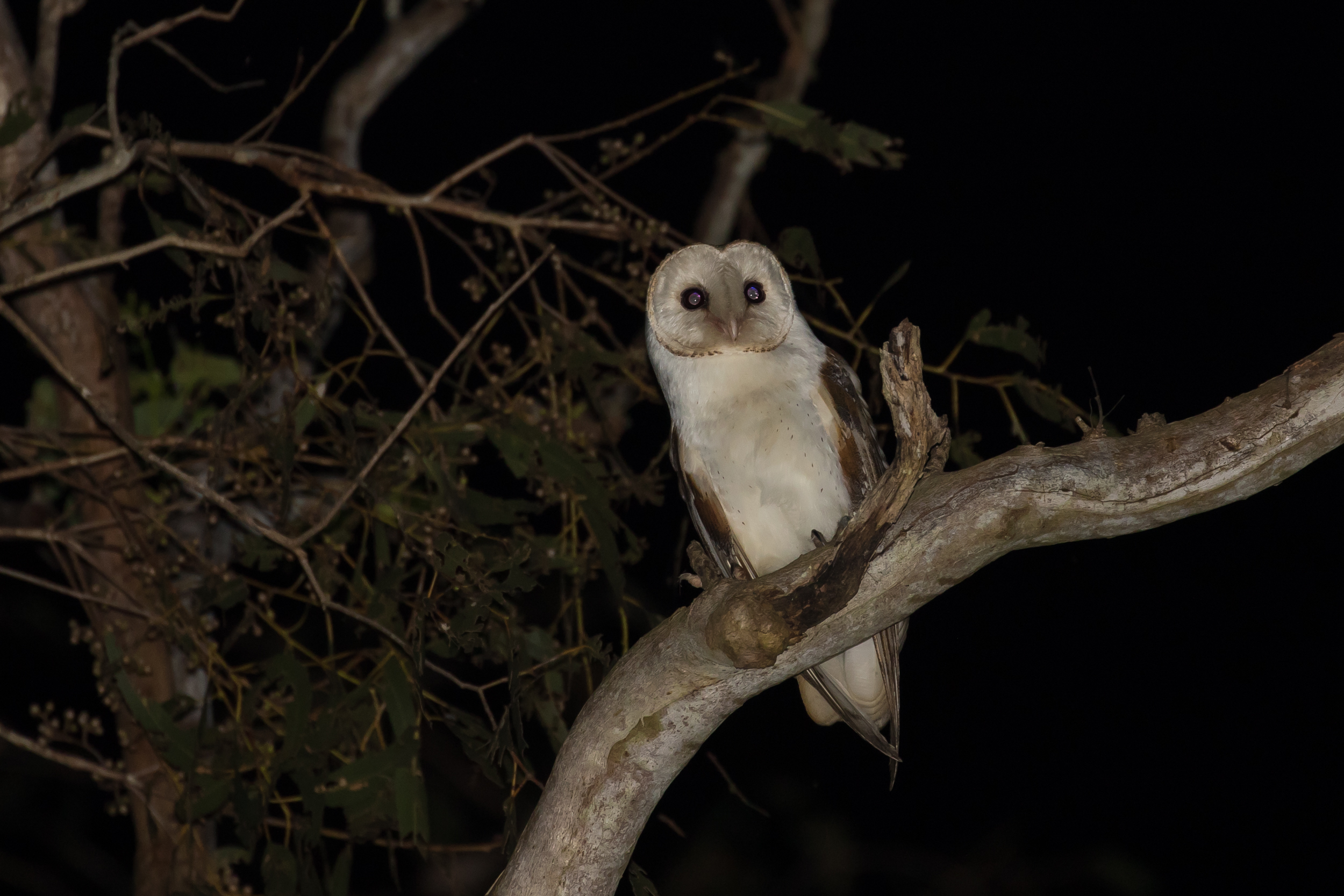
April 21, Day 14
For our final day we left KFP while it was still dark at 6am and headed south to Atherton, picking up fuel, coffees and a Bacon and Egg McMuffin in Mareeba en route. Our final main joint target for the week was Golden Bowerbird. This was a top target for a whole heap of reasons: it’s a bowerbird (duh!), it’s brilliant looking, it is range-and-altitude restricted, it has a wacky song, it’s placed in its own genus (Prionodura), and it builds a very funky “maypole” bower (the only one of Australia’s bowerbirds to go for this construction). We had dipped on Mt Lewis, one of the few reliable spots for it, but we had some gen from SA birding mate Neil Edwards for a spot at Mt Hypipamee.
We pulled into the carpark at Mt Hypipamee (Carol corrected my uneducated pronunciation — apparently it’s “High-pippa-mee”) at around 7.45. Near the car a Tooth-billed Bowerbird was singing. I was keen for better views than I’d had on Mt Lewis, and for a chance for a photo, but it was also a lower priority than its golden cousin, so it was shelved until later. We followed Neil’s written instructions to try to find the bower. Unfortunately we initially had trouble working out which landmarks he actually meant and spent a bit of time walking up and down the access road near the car-park, and then bumbling about in the forest itself, unable to track down the site of the bower. While regrouping and messaging Neil we heard for the first time that strange, other-worldly beating of Golden Bowerbird’s “song” — I was reminded of the even weirder and more complex song of its close relative, Vogelkop Bowerbird — and made our way into the forest following the source. Now that I was not looking, I bumped almost immediately into the bower, and as the bird continued to sing we tried to find a reasonably inconspicuous spot from which to view, in the hope it would come down to the bower itself. In fact it didn’t work like that at all. The bird, apparently aware of our presence flew in, a streak of bright yellow-gold and landed about 10m behind us. I turned 180 and had amazing views for a short while but Paul, a couple of metres to my left could not get on it. I held back trying to photograph while trying to get him on it, and then finally squeezed out only 3 badly blurred pictures, 1/15s at ISO6400. Have I mentioned that it is dark in the forest?? The stonker disappeared for a bit, and occasionally I clocked a flash of golden as it moved about the forest. After a while it returned to a spot behind us but a little further away, and again cognisant of our presence, sat still for a minute or two making a soft contact noise almost seemingly for our benefit. Of course we filled our CF and SD cards with dark, motion-blurred images in the hope that a few would turn out, which they did! I’m not very good at conveying the excitement of these moments, but it was another amazing highlight of the trip, almost completing a clean-up of our targets. We took a few pictures of the bower, a double maypole, and also of another smaller single-pole construction nearby.


Back at the car I walked to the toilets to avail myself of the facilities, and luckily had taken camera with me. Just by the ladies loo a large dark bird flushed from low to high, but still very close, and when I landed bins on it I realised I’d just come face-to-face with a Tooth-billed Bowerbird. Although nature was calling, I banged out a few pics, though didn’t alert Paul. I felt a pang of guilt, but shouting would have flushed it deeper into the forest, and I didn’t think I could manage the walk across the car-park and back again while keeping my underpants in their pristine state. I reconciled the dilemma with the knowledge that Paul did not need TBBB.
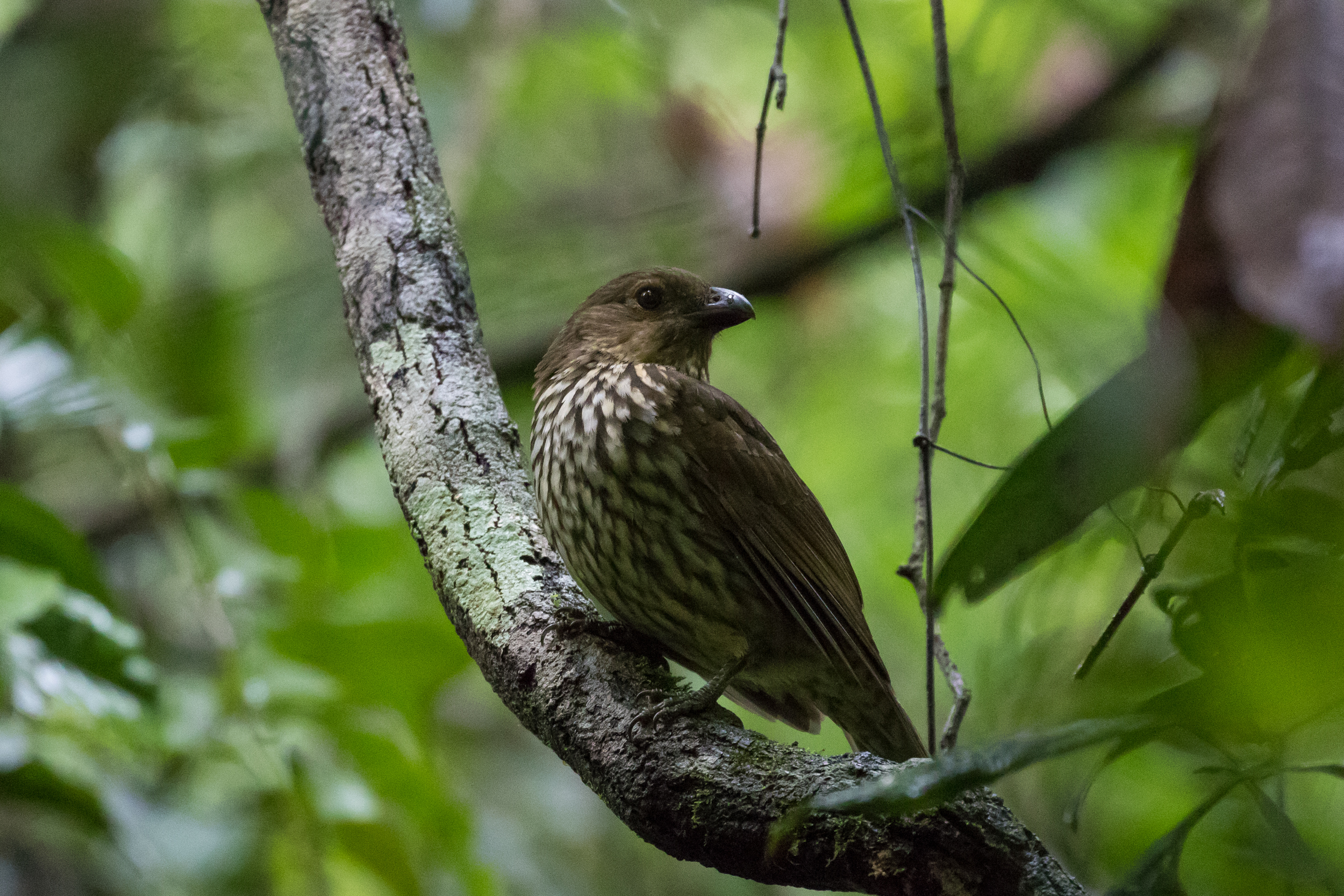
A Grey-headed Robin was performing nicely around the picnic area as I returned, and we then walked the loop to the crater lake, seeing few birds, but enjoying the amazing scenery. The Barron River has its source near here and the loop track spends half of its length alongside a series of waterfalls that were in full voice following the last few days’ rainfall. It was interesting to see it here at the source, having crossed it several times in various places on the tablelands, and visited the Barron Falls at Kuranda a couple of weeks earlier. I imagine that with all the rain they would have swelled from the trickle I saw with the family, to a proper wet-season torrent as seen in the tourist brochures, but we would not have time to revisit today or tomorrow before our morning flights home.
The remainder of the day was pretty quiet and did not yield any new birds. We visited Hasties Swamp hoping for Cotton Pygmy-goose (a potential low-priority lifer for us both) but birds that had been reported a week or so ag on ebird were no longer present (or at least, no longer visible). A flock of 50 or so Chestnut-breasted Mannikin and a similar number of Plumed Whistling-duck were nice encounters but otherwise we recorded some list padders like Swamphen, Hardhead, Australasian Grebe, Darter and Pacific Black Duck.
We checked into Chambers just as the rain started again in earnest, so we birded from the balcony of our lodge for a while and snoozed a bit. Our plan was to have dinner at Yungaburra Pub fairly early, and then come back to Chambers where we were told a Striped Possum had been making visits fairly early, around 7.45 or so. If we felt up for it we might go spotlighting for Owls later, but that was not certain.
The rain had eased somewhat as we arrived at the pub. We had just ordered a couple of pints and our meals when I noticed a text arrive from Alan Gillanders. I don’t know if he’d seen us drive or walk through the village, or if this was sheer coincidence, but his message read: “If still in the area and able to come back to Yungaburra give me a call about the LS Owl”. Of course the very next thing I did was to call: “Yes we are in the area. In fact we are un the pub right now!”. Alan provided us with some really precise gen to an active nest not far from Yungaburra — what a scholar and a gentleman!! He also advised that he’d most recently seen the birds in the hour after dark, so pints and chicken wings were demolished in no time, and after a rapid detour back to Chambers to collect optics we rocked up at the site at about 19.40. Torches set to red LED, we scanned the area but there was no action around the spot we believed to be the nest hole. Then as I swept another time I caught a flash of red reflected from a couple of metres above the hole. It was only a single point-light source, but it was brighter than the water drop and spider reflections so I pointed the torch back, focused my bins as best I could with one hand, and all of a sudden, one reflection became two, as a gorgeous Lesser Sooty Owl turned it head to face me! It flew to out of sight, but I was able to relocate it by walking 15 metres to my right, and it seemed a little more settled. It had its back to us, and occasionally as it turned its fgace showed a mixture of indifference and grumpiness. For a minute or so we switched briefly to white LEDs while I bagged a photo. I took only about 4 or 5 pics and as soon as I had one in focus we left it in peace. This was really the icing on the cake; to pick up both Golden Bowerbird and Lesser Sooty Owl on our final day felt extraordinarily fortunate.
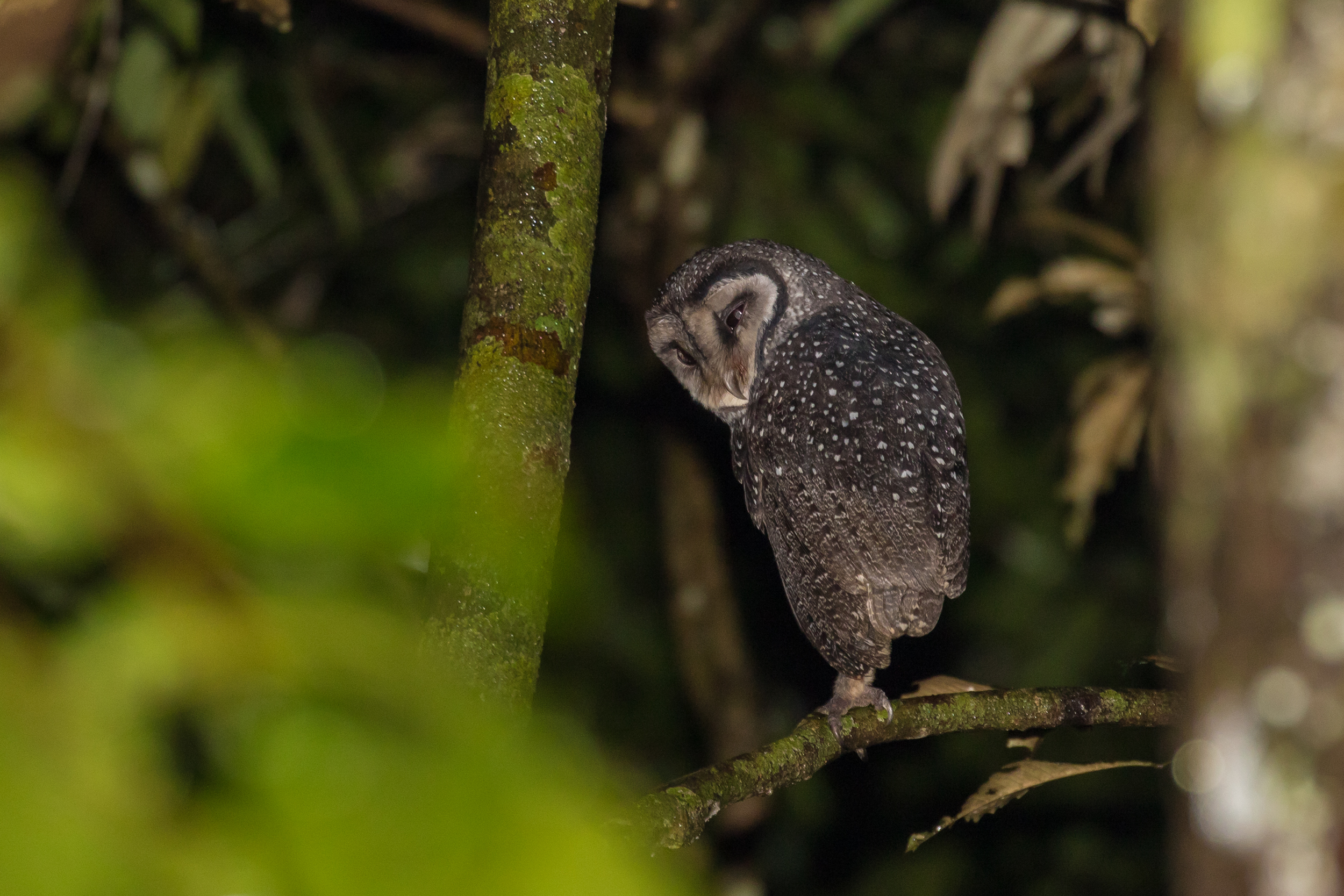
Back at Chambers our evening vigil in the rain did not yield the hoped-for Striped Possum and we had to make do with a Sugar Glider, and Paul found a fabulous Boyd’s Forest Dragon.


April 23, Day 15.
Our final morning yielding nothing new, making this the first day of the whole trip that I did not score a lifer or Australian tick. We had an hour or two before we had to leave, so birded from the balcony over breakfast and walked the grounds. Paul managed a good view of a male Victoria’s Riflebird (though not a display), and also picked up Spotted Catbird and Tooth-billed Bowerbird. This latter bird was one I had tried for each morning 10 days ago. Of course now that I’d found it elsewhere, here it was flaunting its presence in exactly the spot I had spent a long time looking. Other birds of note were Spectacled Monarch, Double-eyed Fig-parrot, Large-billed Scrubwren, Brown Gerygone, and Little Shrikethrush. A coffee and walk in the park in Yungaburra was a last-ditch attempt to find a Baza for Paul, but this ended in failure, though we did find seven Bush Stone-curlews in and around one of the flowerbeds, and I had only my second encounter with White-headed Pigeons for the trip. We rocked into Cairns airport at about 10.30am, bang on time to check in for our flights home.
After an inauspicious start to the second week, and despite terrible weather for most of it, we’d had a very successful and immensely enjoyable time, seeing pretty much all of the specialties I hoped for, including utterly stonking A-listers like Victoria’s Riflebird, Golden Bowerbird, Southern Cassowary and Buff-breasted Paradise Kingfisher. I’d added 42 lifers and a further 10 Australian ticks, and when I counted back I realised that my Australian list had swollen to over 600; 603 to be precise, meaning Fernwren was #600. In other post-trip reckoning, it was frustrating and ironic to see on social media a mere 48 hours after our departure, Nordy was re-found on the Cairns Esplanade.
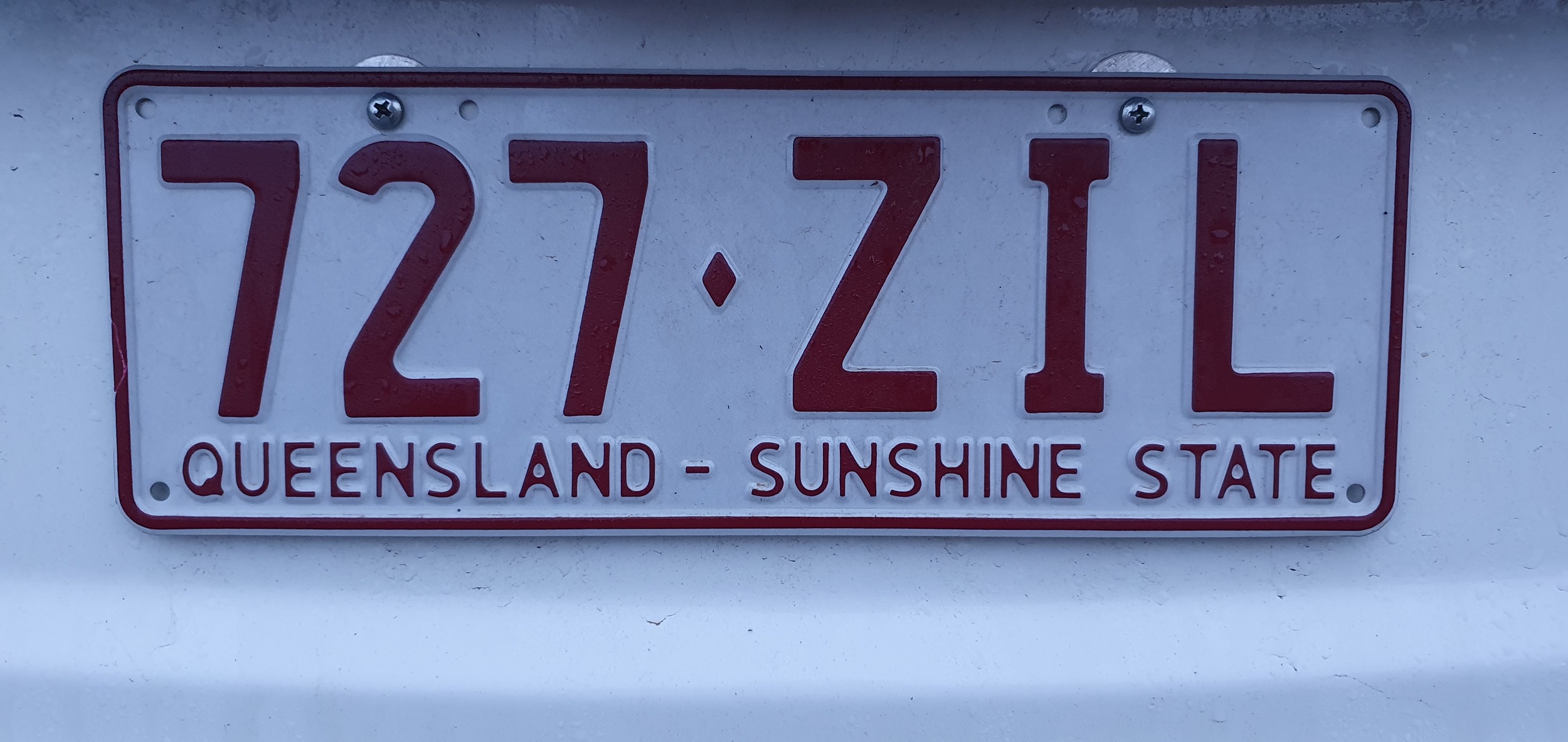
| Species | Location(s) | ||
| 1 | Southern Cassowary | * | Frogs Hollow, South Mission Beach); Jindalda Boardwalk, Daintree |
| 2 | Magpie Goose | Centenary Lakes | |
| 3 | Plumed Whistling-Duck | Hasties Swamp National Park | |
| 4 | Radjah Shelduck | Centenary Lakes | |
| 5 | Pacific Black Duck | Centenary Lakes and some other sites | |
| 6 | Hardhead | Hasties Swamp National Park | |
| 7 | Australian Brushturkey | most rainforest places | |
| 8 | Orange-footed Scrubfowl | most rainforest places; also Green Island | |
| 9 | Australasian Grebe | Hasties Swamp National Park | |
| 10 | Rock Dove | ||
| 11 | White-headed Pigeon | Yungaburra | |
| 12 | Brown Cuckoo-Dove | Various | |
| 13 | Pacific Emerald Dove | Chambers, Mt Lewis | |
| 14 | Squatter Pigeon | * | Mount Molloy |
| 15 | Diamond Dove | Mulligan Highway, Mount Carbine AU-QLD -16.50106, 145.01554 | |
| 16 | Peaceful Dove | Kuranda Village; Cairns Esplanade, various | |
| 17 | Bar-shouldered Dove | Palm cove; KFP; various | |
| 18 | Wompoo Fruit-Dove | A | Kuranda Village, Chambers |
| 19 | Superb Fruit-Dove | h.o. Black Mountain Road near Cassowary House | |
| 20 | Torresian Imperial-Pigeon | Cairns Esplanade | |
| 21 | Australian Bustard | West Mary Rd, Maryfarms | |
| 22 | Shining Bronze-Cuckoo | h.o. Chambers | |
| 23 | Chestnut-breasted Cuckoo | * | Clacherty Road, Julatten |
| 24 | Fan-tailed Cuckoo | Chambers; Carr Rd, Julatten Rainforest Lodge | |
| 25 | Australian Swiftlet | Kuranda Village | |
| 26 | Buff-banded Rail | Green Island National Park | |
| 27 | Eurasian Coot | Hasties Swamp National Park | |
| 28 | Australasian Swamphen | Hasties Swamp National Park | |
| 29 | Pale-vented Bush-hen | * | Centenary Lakes |
| 30 | Red-necked Crake | * | Kingfisher Park Birdwatchers Lodge |
| 31 | Bush Stone-curlew | Centenary Lakes; Cairns, Yungaburra, KFP | |
| 32 | Australian Pied Oystercatcher | Cairns Esplanade | |
| 33 | Pacific Golden-Plover | Green Island National Park | |
| 34 | Masked Lapwing | Cairns Esplanade | |
| 35 | Greater Sand-Plover | Cairns Esplanade | |
| 36 | Red-capped Plover | Cairns Esplanade | |
| 37 | Whimbrel | Cairns Esplanade | |
| 38 | Eastern Curlew | Cairns Esplanade | |
| 39 | Bar-tailed Godwit | Cairns Esplanade | |
| 40 | Ruddy Turnstone | Green Island National Park | |
| 41 | Great Knot | Cairns Esplanade | |
| 42 | Red-necked Stint | Cairns Esplanade | |
| 43 | Terek Sandpiper | Cairns Esplanade | |
| 44 | Grey-tailed Tattler | Cairns Esplanade | |
| 45 | Common Greenshank | Cairns Esplanade | |
| 46 | Nordmann’s Greenshank | A | Cairns Esplanade |
| 47 | Silver Gull | Cairns Esplanade | |
| 48 | Common Noddy | Green Island National Park | |
| 49 | Black Noddy | A | Green Island National Park |
| 50 | Little Tern | Newell Beach, Boat Ramp | |
| 51 | Australian (Gull-billed) Tern | Cairns Esplanade | |
| 52 | Crested Tern | Palm cove | |
| 53 | Black-necked Stork | Cairns Esplanade | |
| 54 | Australasian Darter | Hasties Swamp National Park | |
| 55 | Australian Pelican | Cairns Esplanade | |
| 56 | Great Egret | Cairns Esplanade | |
| 57 | Intermediate Egret | Daintree Village Boat Cruise | |
| 58 | Little Egret | Cairns Esplanade | |
| 59 | Eastern Reef Egret | Green Island National Park | |
| 60 | Cattle Egret | Daintree Village Boat Cruise | |
| 61 | Striated Heron | Centenary Lakes | |
| 62 | Osprey | Green Island National Park | |
| 63 | Pacific Baza | A | Yungaburra |
| 64 | Wedge-tailed Eagle | Daintree Village Boat Cruise | |
| 65 | Grey Goshawk | Centenary Lakes; Chambers; Mossman | |
| 66 | Brown Goshawk | Hurricane Road, Desailly | |
| 67 | Black Kite | Barron River at Kennedy Hwy and Mulligan Hwy | |
| 68 | Whistling Kite | Daintree Village Boat Cruise | |
| 69 | Brahminy Kite | Newell Beach, Boat Ramp | |
| 70 | White-bellied Sea-Eagle | Kuranda Village; Daintree Village Boat Cruise | |
| 71 | Lesser Sooty Owl | * | Curtain Fig Tree |
| 72 | Azure Kingfisher | Daintree Village Boat Cruise | |
| 73 | Little Kingfisher | A | Centenary Lakes; Daintree Village Boat Cruise |
| 74 | Laughing Kookaburra | Kingfisher Park Birdwatchers Lodge; various | |
| 75 | Blue-winged Kookaburra | Hurricane Road, Desailly | |
| 76 | Forest Kingfisher | Daintree Village Boat Cruise | |
| 77 | Torresian Kingfisher | Centenary Lakes | |
| 78 | Sacred Kingfisher | Cairns Esplanade | |
| 79 | Buff-breasted Paradise-Kingfisher | * | Carr Rd, Julatten; Mt Lewis lower slopes |
| 80 | Rainbow Bee-eater | Centenary Lakes; various | |
| 81 | Dollarbird | Daintree Village Boat Cruise | |
| 82 | Nankeen Kestrel | Mossman | |
| 83 | Galah | Hurricane Road, Desailly | |
| 84 | Sulphur-crested Cockatoo | Kuranda Village; Chambers; various | |
| 85 | Australian King-Parrot | Black Mountain Road near Cassowary House; Mt Lewis | |
| 86 | Pale-headed Rosella | Mulligan Highway, Mount Carbine AU-QLD -16.50106, 145.01554 | |
| 87 | Double-eyed Fig-Parrot | * | Chambers Rainforest Lodge; Cairns Esplanade |
| 88 | Rainbow Lorikeet | Cairns Esplanade | |
| 89 | Noisy Pitta | h.o. Kingfisher Park Birdwatchers Lodge | |
| 90 | Spotted Catbird | * | Chambers Rainforest Lodge |
| 91 | Tooth-billed Bowerbird | * | Mt Lewis; Mt Hypipamee |
| 92 | Golden Bowerbird | * | Mount Hypipamee National Park |
| 93 | Great Bowerbird | Mount Molloy | |
| 94 | White-throated Treecreeper | Chambers; Mt Lewis | |
| 95 | Lovely Fairywren | * | Daintree Village |
| 96 | Eastern Spinebill | Mt Lewis; various | |
| 97 | Yellow-spotted Honeyeater | * | Djiru NP; Cassowary House; KFP |
| 98 | Lewin’s Honeyeater | * | Chambers Rainforest Lodge; KFP; Mt Lewis |
| 99 | Graceful (Cryptic) Honeyeater | * | Lacey Creek Forest Walk, Djiru NP |
| 100 | Yellow Honeyeater | * | Yungaburra; Mareeba |
| 101 | Bridled Honeyeater | * | Chambers Rainforest Lodge; Mt Lewis |
| 102 | Varied Honeyeater | A | Palm Cove; Cairns Esplanade |
| 103 | Dusky Honeyeater | Chambers Rainforest Lodge; various | |
| 104 | Scarlet Honeyeater | Chambers Rainforest Lodge; Cairns airport; Mareeba | |
| 105 | Brown Honeyeater | Barron River at Kennedy Hwy, Mareeba | |
| 106 | Blue-faced Honeyeater | Jack Bethel Park, Mareeba | |
| 107 | White-throated Honeyeater | Centenary Lakes | |
| 108 | Macleay’s Honeyeater | * | Chambers; Djiru NP; KFP |
| 109 | Hornbill (Helmeted) Friarbird | * | Lacey Creek Forest Walk; various |
| 110 | Noisy Friarbird | Hurricane Road, Desailly | |
| 111 | Striated Pardalote | Jack Bethel Park, Mareeba; Mulligan Hwy | |
| 112 | Fernwren | * | Mt Lewis |
| 113 | Yellow-throated Scrubwren | Mt Lewis | |
| 114 | Atherton Scrubwren | * | Mt Lewis |
| 115 | Large-billed Scrubwren | Chambers; Lake Eacham | |
| 116 | Mountain Thornbill | * | Mt Lewis |
| 117 | Fairy Gerygone | * | Black Mountain Road near Cassowary House |
| 118 | Large-billed Gerygone | Daintree Village Boat Cruise | |
| 119 | Brown Gerygone | Chambers Rainforest Lodge | |
| 120 | Chowchilla | * | Mt Lewis |
| 121 | Barred Cuckooshrike | * | Black Mountain Road near Cassowary House |
| 122 | Black-faced Cuckooshrike | West Mary Rd, Maryfarms; Mulligan Hwy | |
| 123 | White-bellied Cuckooshrike | Daintree Village Boat Cruise; Mulligan Hwy | |
| 124 | White-winged Triller | Black Mountain Road near Cassowary House | |
| 125 | Varied Triller | Black Mountain Road near Cassowary House | |
| 126 | Common Cicadabird | A | Centenary Lakes; Black Mountain Road near Cassowary House |
| 127 | Varied Sittella | Mulligan Highway, Mount Carbine AU-QLD -16.50106, 145.01554 | |
| 128 | Eastern Whipbird | various | |
| 129 | Bower’s Shrikethrush | * | Chambers Rainforest Lodge |
| 130 | Little Shrikethrush | Kuranda Village; Chambers; | |
| 131 | Golden Whistler | Mt Lewis | |
| 132 | Grey Whistler | Black Mountain Road near Cassowary House | |
| 133 | Rufous Whistler | Hasties Swamp National Park | |
| 134 | Yellow Oriole | 4 mile beach | |
| 135 | Australasian Figbird | Kuranda Village | |
| 136 | Yellow-breasted Boatbill | A | Chambers; Black Mtn Rd near Cassowary House |
| 137 | White-breasted Woodswallow | Centenary Lakes; various | |
| 138 | Black-faced Woodswallow | Mulligan Highway, Mount Carbine AU-QLD -16.50106, 145.01554 | |
| 139 | Pied Butcherbird | Hurricane Road, Desailly | |
| 140 | Black Butcherbird | Centenary Lakes; KFP | |
| 141 | Australian Magpie | Hurricane Road, Desailly | |
| 142 | Pied Currawong | Chambers Rainforest Lodge | |
| 143 | Willie Wagtail | Centenary Lakes; various | |
| 144 | Rufous Fantail | Chambers Rainforest Lodge | |
| 145 | Grey Fantail | Mt Lewis | |
| 146 | Spangled Drongo | Daintree Village Boat Cruise | |
| 147 | Victoria’s Riflebird | * | Chambers Rainforest Lodge |
| 148 | Spectacled Monarch | Chambers Rainforest Lodge; Cassowary House; Mt Lewis | |
| 149 | Pied Monarch | * | Chambers Rainforest Lodge |
| 150 | Magpie-lark | Cairns Esplanade; various | |
| 151 | Shining Flycatcher | Centenary Lakes | |
| 152 | Apostlebird | Hurricane Road, Desailly | |
| 153 | Pale-yellow Robin | Chambers; Curtain Fig Tree; Mt Lewis | |
| 154 | White-browed Robin | * | Jack Bethel Park, Mareeba |
| 155 | Grey-headed Robin | * | Chambers Rainforest Lodge; Mt Lewis; Mt Hypipamee |
| 156 | Golden-headed Cisticola | Mount Molloy | |
| 157 | Welcome Swallow | Cairns Esplanade | |
| 158 | Fairy Martin | Newell Beach, Boat Ramp | |
| 159 | Tree Martin | Daintree Village Boat Cruise | |
| 160 | Silvereye | Green Island National Park; various | |
| 161 | Metallic Starling | A | Centenary Lakes |
| 162 | Common Myna | Centenary Lakes | |
| 163 | Mistletoebird | Centenary Lakes; various | |
| 164 | Olive-backed Sunbird | Kuranda Village; Daintree; various | |
| 165 | Red-browed Finch | Kingfisher Park Birdwatchers Lodge; Mt Lewis | |
| 166 | Black-throated Finch | * | Mulligan Highway, Mount Carbine AU-QLD -16.50106, 145.01554 |
| 167 | Blue-faced Parrotfinch | * | Mt Lewis |
| 168 | Scaly-breasted Munia | A | Centenary Lakes |
| 169 | Chestnut-breasted Mannikin | Hasties Swamp National Park | |
| 170 | House Sparrow | Green Island National Park |

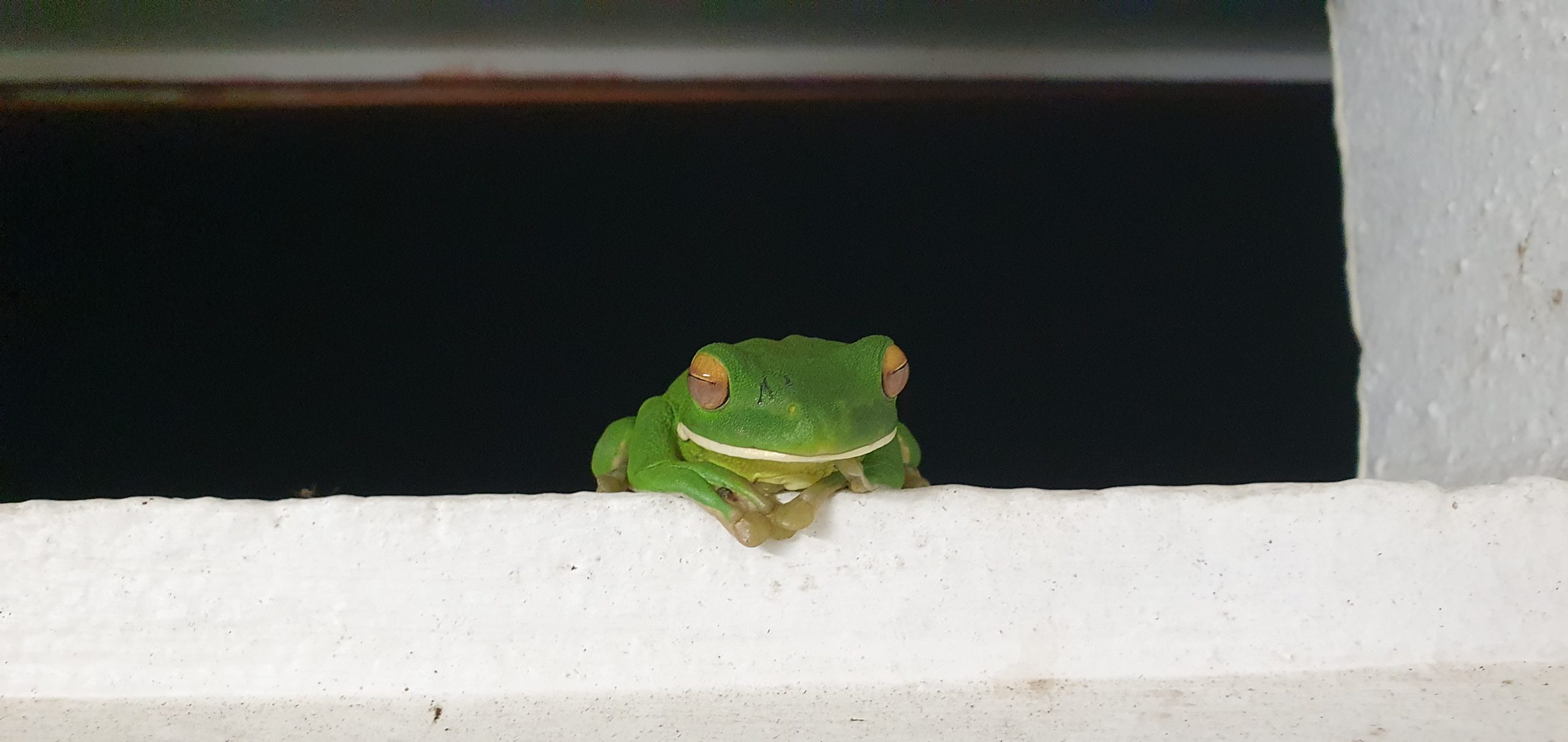
Love it. You have an exciting life Ian
:-). It’s what you make it! Birding is not for everyone, but it certainly brings a lot of pleasure and adventure to my life.